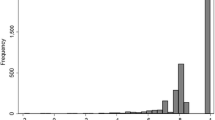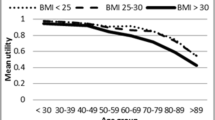Abstract
Purpose
To analyse the clinical, sociodemographic and socioeconomic factors that influence perceived quality of life (QoL) in a community sample of 33,241 people aged 65+ and to examine the relationship with models of social welfare in Europe.
Methods
This was a cross-sectional study of data from Wave 5 (2013) of the Survey of Health, Ageing and Retirement in Europe (SHARE). The instruments used in the present study were as follows: sociodemographic data, CASP-12 (QoL), EURO-D (depression), indicators of life expectancy and suicide (WHO), and economic indicators (World Bank). Statistical analysis included bivariate and multilevel analyses.
Results
In the multilevel analysis, greater satisfaction in life, less depression, sufficient income, better subjective health, physical activity, an absence of functional impairment, younger age and participation in activities were associated with better QoL in all countries. More education was only associated with higher QoL in Eastern European and Mediterranean countries, and only in the latter was caring for grandchildren also related to better QoL. Socioeconomic indicators were better and QoL scores higher (mean = 38.5 ± 5.8) in countries that had a social democratic (Nordic cluster) or corporatist model (Continental cluster) of social welfare, as compared to Eastern European and Mediterranean countries, which were characterized by poorer socioeconomic conditions, more limited social welfare provision and lower QoL scores (mean = 33.5 ± 6.4).
Conclusions
Perceived quality-of-life scores are consistent with the sociodemographic and clinical characteristics of participants, as well as with the socioeconomic indicators and models of social welfare of the countries in which they live.

Similar content being viewed by others
References
World Health Organization. (1995). The World Health Organization Quality of Life assessment (WHOQOL): Position paper from the World Health Organization. Social Science Medicine, 4, 1403–1409.
Layte, R., Sexton, E., & Savva, G. (2013). Quality of life in older age: Evidence from an Irish cohort study. Journal of the American Geriatrics Society, 61(S2), 99–305.
Shrira, A. (2014). Greater age-related decline in markers of physical, mental and cognitive health among Israeli older adults exposed to lifetime cumulative adversity. Aging and Mental Health, 18, 610–618.
Blane, D., Netuveli, G., & Montgomery, S. M. (2008). Quality of life, health and physiological status and change at older ages. Social Science and Medicine, 66, 1579–1587.
Wikman, A., Wardle, J., & Steptoe, A. (2011). Quality of life and affective well-being in middle-aged and older people with chronic medical illnesses: A cross-sectional population based study. Plos One, 6, e18952.
Netuveli, G., Wiggins, R. D., Hildon, Z., Montgomery, S. M., & Blane, D. (2006). Quality of life at older ages: Evidence from the english longitudinal study of aging (wave 1). Journal of Epidemiology and Community Health, 60, 357–363.
Palgi, Y., Shrira, A., & Zaslavsky, O. (2015). Quality of life attenuates age-related decline in functional status of older adults. Quality of Life Research, 24, 1835–1843.
Shrira, A. (2012). The effect of lifetime cumulative adversity on change and chronicity in depressive symptoms and quality of life in older adults. International Psychogeriatrics, 24, 1988–1997.
Schaan, B. (2013). Widowhood and depression among older Europeans—the role of gender, caregiving, marital quality, and regional context. Journals of Gerontology Series B Psychological Sciences and Social Sciences, 68, 431–442.
von dem Knesebeck, O., Wahrendorf, M., Hyde, M., & Siegrist, J. (2007). Socio-economic position and quality of life among older people in 10 European countries: Results of the SHARE study. Ageing and Society, 27, 269–284.
Siegrist, J., & Wahrendorf, M. (2009). Participation in socially productive activities and quality of life in early old age: Findings from SHARE. Journal of European Social Policy, 19, 317–326.
Nimrod, G., & Shrira, A. (2016). The paradox of leisure in later life. Journals of Gerontology Series B Psychological Sciences and Social Sciences, 71, 106–111.
Neuberger, F. S., & Haberkern, K. (2014). Structured ambivalence in grandchild care and the quality of life among European grandparents. European Journal of Ageing, 11, 171–181.
Khazaee-Pool, M., Sadeghi, R., Majlessi, F., & Rahimi Foroushani, A. (2015). Effects of physical exercise programme on happiness among older people. Journal of Psychiatric and Mental Health Nursing, 22, 47–57.
Motel-Klingebiel, A., Romeu-Gordo, L., & Betzin, J. (2009). Welfare states and quality of later life: Distributions and predictions in a comparative perspective. European Journal of Ageing, 6, 67–78.
Niedzwiedz, C. L., Katikireddi, S. V., Pell, J. P., & Mitchell, R. (2014). Socioeconomic inequalities in the quality of life of older Europeans in different welfare regimes. European Journal of Public Health, 24, 364–370.
von dem Knesebeck, O., Hyde, M., Higgs, P., Kupfer, A., & Siegrist, J. (2005). Quality of life and Well-Being. In A. Börsch-Supan, A. Brugiavini, H. Jürges, J. Mackenbach, J. Siegrist, & G. Weber (Eds.), Health, ageing and retirement in Europe—first results from the survey of health, ageing and retirement in Europe (pp. 199–203). Mannheim: Mannheim Research Institute for the Economics of Aging (MEA).
Sapir, A. (2006). Globalisation and the reform of European social models. Journal of Common Market Studies, 44, 369–390.
Whelan, C. T., & Maître, B. (2010). Welfare regime and social class variation in poverty and economic vulnerability in Europe: An analysis of EU-SILC. Journal of European Social Policy, 20, 316–332.
Murray, C. J., Richards, M. A., Newton, J. N., Fenton, K. A., Anderson, H. R., Atkinson, C., et al. (2013). UK health performance: Findings of the global burden of disease study 2010. Lancet, 381, 997–1020.
World Health Organization (WHO). (2014). Preventing suicide: A global imperative (pp. 80–87). Geneva: WHO. http://apps.who.int/iris/bitstream/10665/131056/1/9789241564779_eng.pdf. Accessed 20 Oct 2015.
Malter, F., & Börsch-Supan, A. (Eds.). (2015). SHARE Wave 5: Innovations & methodology. Munich: Max Planck Institute for Social Law and Social Policy.
Prince, M. J., Reischies, F., Beekman, A. T. F., Fuhrer, R., Jonker, C., Kivela, S. L., et al. (1999). Development of the EURO-D scale—a European union initiative to compare symptoms of depression in 14 European centres. British Journal of Psychiatry, 174, 330–338.
Hyde, M., Wiggins, R. D., Higgs, P., & Blane, D. B. (2003). A measure of quality of life in early old age: the theory, development and properties of a needs satisfaction model (CASP-19). Aging and Mental Health, 7, 86–94.
World Health Organization (WHO). (2013). Life expectancy at birth and Healthy life expectancy at birth. http://apps.who.int/gho/data/node.main.688?lang=en. Accessed 25 Oct 2015.
The World Bank. (2013). GDP per capita, PPP (current international $). http://data.worldbank.org/indicator/NY.GDP.PCAP.PP.CD?order=wbapi_data_value_2013+wbapi_data_value&sort=desc. Accessed 15 Dec 2015.
Cohen, J. (1973). Eta-squared and partial eta-squared in fixed factor ANOVA designs. Educational and Psychological Measurement, 33, 107–112.
Cohen, J. (1988). Statistical power analysis for the behavioral sciences (2nd ed.). Hillsdale NJ: Lawrence Erlbaum.
European Commission. (2013). Quality of life in Europe: Subjective well-being (pp. 5). Luxembourg: Publications Office of the European Union http://www.eurofound.europa.eu/es/publications/report/2013/quality-of-life-social-policies/quality-of-life-in-europe-subjective-well-being. Accessed 1 Dec 2015.
Pardo, A., Ruiz, M. A., & San Martín, R. (2007). Cómo ajustar e interpreter modelos multinivel con SPSS. Psicothema, 19, 308–321.
Sexton, E., King-Kallimanis, B. L., Layte, R., & Hickey, A. (2015). CASP-19 special section: how does chronic disease status affect CASP quality of life at older ages? Examining the WHO ICF disability domains as mediators of this relationship. Aging and Mental Health, 19, 622–633.
Titelman, D., Oskarsson, H., Wahlbeck, K., Nordentoft, M., Mehlum, L., Jiang, G.-X., et al. (2013). Suicide mortality trends in the Nordic countries 1980–2009. Nordic Journal of Psychiatry, 67, 414–423.
Morin, J., Wiktorsson, S., Marlow, T., Olesen, P. J., Skoog, I., & Waern, M. (2013). Alcohol use disorder in elderly suicide attempters: A comparison study. American Journal of Geriatric Psychiatry, 21, 196–203.
Wu, J., Värnik, A., Tooding, L. M., Värnik, P., & Kasearu, K. (2014). Suicide among older people in relation to their subjective and objective well-being in different European regions. European Journal of Ageing, 11, 131–140.
Watzka, C. (2012). Social conditions of suicides in Austria. An overview on risk and protective factors. Neuropsychiatrie, 26, 95–102.
Hooghe, M., & Vanhoutte, B. (2011). An ecological study of community-level correlates of suicide mortality rates in the Flemish region of Belgium, 1996–2005. Suicide and Life Threatening Behavior, 41, 453–464.
Bray, I., & Gunnell, D. (2006). Suicide rates, life satisfaction and happiness as markers for population mental health. Social Psychiatry and Psychiatric Epidemiology, 41, 333–337.
Knoops, K. T., de Groot, L. C., Kromhout, D., Perrin, A. E., Moreiras-Varela, O., Menotti, A., et al. (2004). Mediterranean diet, lifestyle factors, and 10-year mortality in elderly European men and women: the HALE project. Journal of the American Medical Association, 292, 1433–1439.
Mathers, C. D., Stevens, G. A., Boerma, T., White, R. A., & Tobias, M. I. (2015). Causes of international increases in older age life expectancy. Lancet, 385, 540–548.
Spoerri, A., Zwahlen, M., Bopp, M., Gutzwiller, F., & Egger, M. (2010). Religion and assisted and non-assisted suicide in Switzerland: National Cohort Study. International Journal of Epidemiology, 39, 1486–1494.
Acknowledgments
This paper uses data from SHARE Wave 5 release 1.0.0, as of March 31, 2015 (DOI: 10.6103/SHARE.w5.100). The SHARE data collection has been primarily funded by the European Commission through the 5th Framework Programme (project QLK6-CT-2001-00360 in the thematic programme Quality of Life), through the 6th Framework Programme (projects SHARE-I3, RII-CT-2006-062193, COMPARE, CIT5- CT-2005-028857, and SHARELIFE, CIT4-CT-2006-028812) and through the 7th Framework Programme (SHARE-PREP, N° 211909, SHARE-LEAP, N° 227822 and SHARE M4, N° 261982). Additional funding from the US National Institute on Aging (U01 AG09740-13S2, P01 AG005842, P01 AG08291, P30 AG12815, R21 AG025169, Y1-AG-4553-01, IAG BSR06-11 and OGHA 04-064) and the German Ministry of Education and Research, as well as from various national sources, is gratefully acknowledged (see www.share-project.org for a full list of funding institutions). The authors would like to specifically acknowledge gratefully the Organisme de Salut Pública de la Diputació de Girona (Dipsalut) for the funding, and the Institut d’Assistència Sanitària de Girona (IAS) and the Institut d’Estadística de Catalunya (IDESCAT) for their collaboration.
Funding
The study received funding from European Commission 7th Framework Programme (SHARE M4, No 261982). Project: SHARE (Survey of Health, Ageing and Retirement in Europe).
Author information
Authors and Affiliations
Corresponding author
Ethics declarations
Conflict of interest
All authors declare that they have no conflict of interest.
Ethical approval
All procedures performed in studies involving human participants were in accordance with the ethical standards of the institutional research committee (Institut d’Assistència Sanitària de Girona, IAS) and with the 1964 Helsinki Declaration and its later amendments or comparable ethical standards. All participants signed informed consent.
Rights and permissions
About this article
Cite this article
Conde-Sala, J.L., Portellano-Ortiz, C., Calvó-Perxas, L. et al. Quality of life in people aged 65+ in Europe: associated factors and models of social welfare—analysis of data from the SHARE project (Wave 5). Qual Life Res 26, 1059–1070 (2017). https://doi.org/10.1007/s11136-016-1436-x
Accepted:
Published:
Issue Date:
DOI: https://doi.org/10.1007/s11136-016-1436-x




